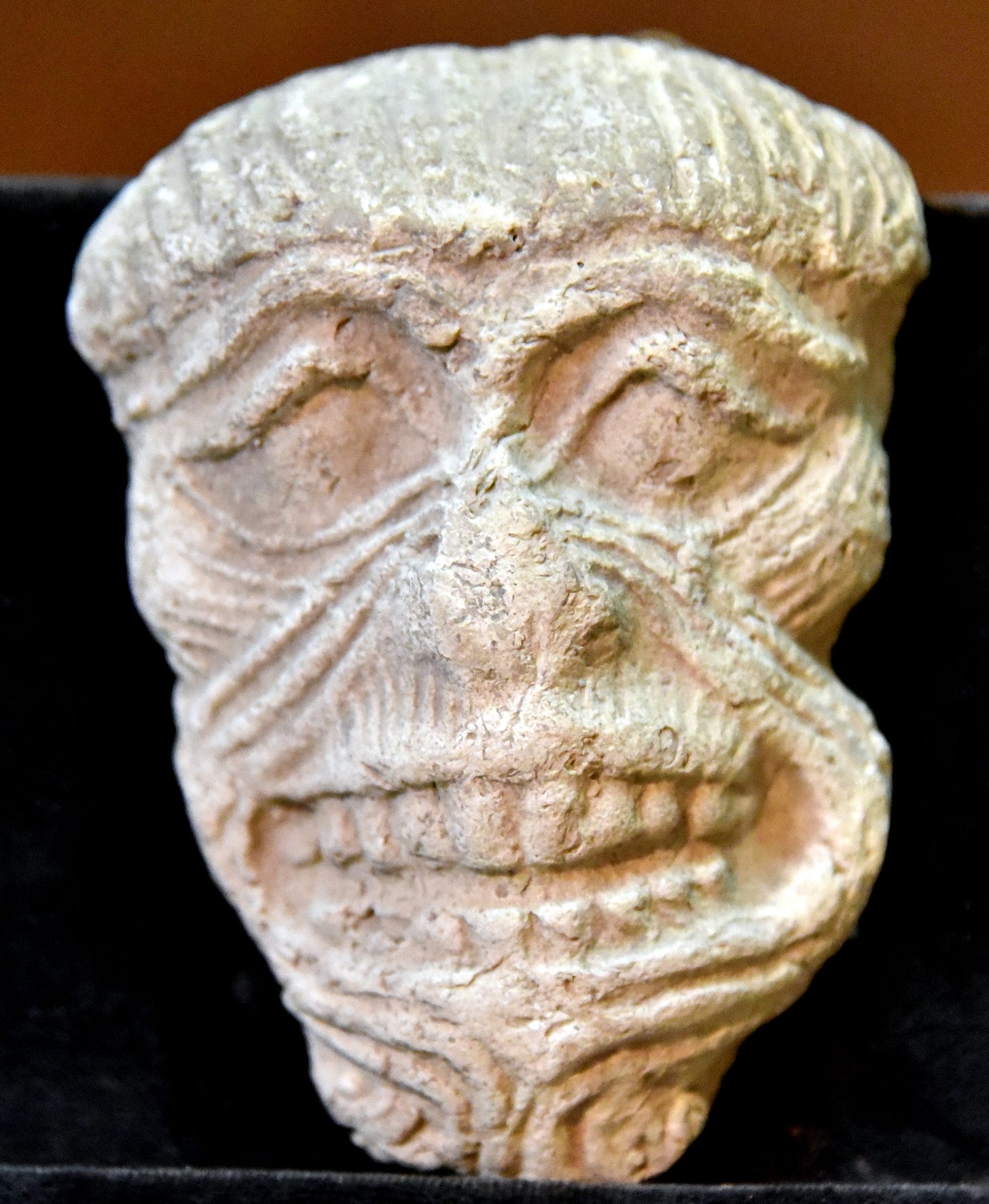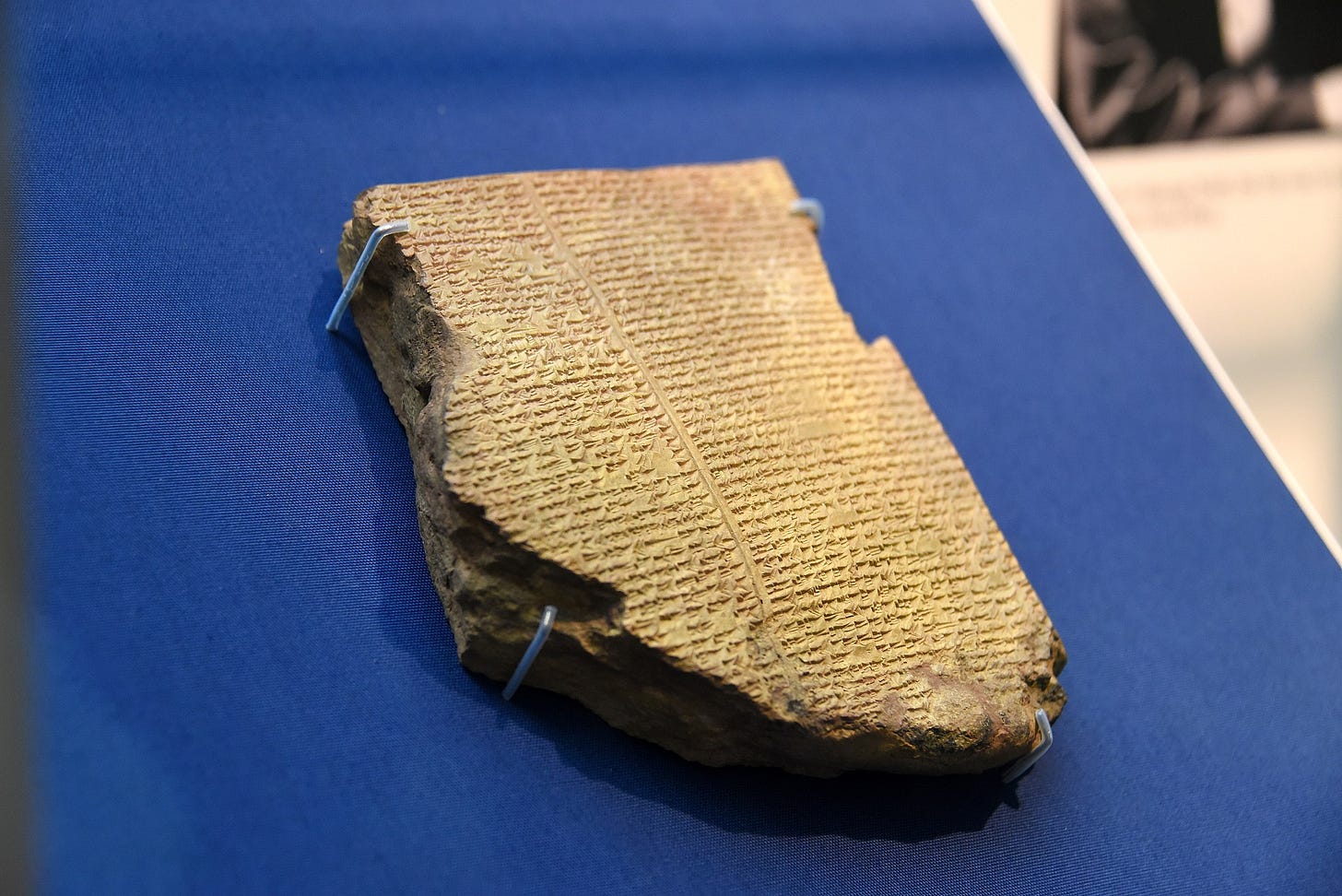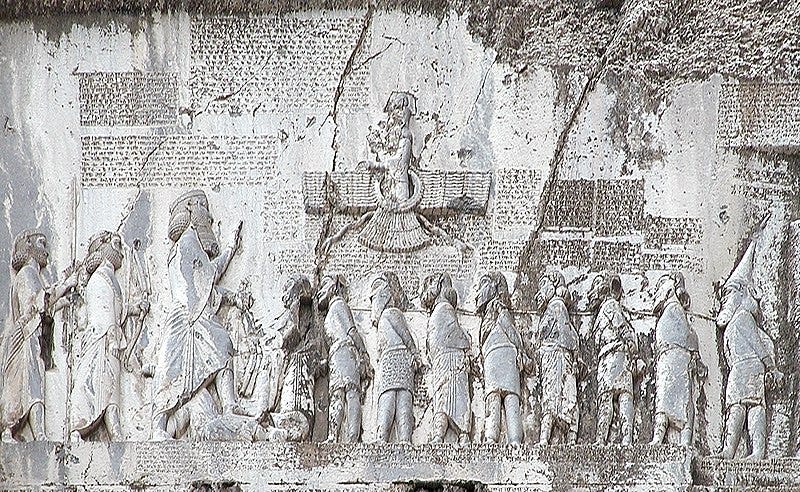[Note: this post has been revised from its original version published in April of 2022.]
The Epic of Gilgamesh is very old. Even the standard version compiled three thousand years ago was based on poems that were another thousand years old, as far away from the editors as Beowulf is from us. At the same time, The Epic of Gilgamesh is very new: only rediscovered in 1872, it has been a part of our cultural imagination for about as long as Middlemarch and Around the World in Eighty Days. Even then, it was unreadable for decades: translators took seventeen years just to figure out the proper pronunciation of the hero: at first, he was Izdubar, or Gistubar. For a while, it was called The Epic of Bilgamesh.
To be fair—and with all due respect to Finnegans Wake—The Epic of Gilgamesh is the most difficult text in the world. The poem was pieced together from thousands of fragments, told in two wildly different dead languages in versions of the stories hundreds of years apart. That it could be found, buried in the sand after thousands of years, and put together at all is a miracle, one that I’ve been reading about in Paul Damrosch’s The Buried Book and Michael Schmidt’s Gilgamesh: The Life of a Poem.
I won’t retell the whole poem here, as there are plenty of summaries and even the most faithful translations only take a couple of hours to read. I will say, though, that I don’t think The Epic of Gilgamesh, in any translation, is an especially good story. There are only four or five real characters in the poem, and Gilgamesh is far and away the least interesting: the wild-man Enkidu, the sultry sex-god Shamhat and her Godzilla-sized pet bull, mysterious wise man Uta-Napishti, and sympathetic monster Humbaba fill the poem with magic, danger, sex, and comedy. Gilgamesh, on the other hand, is a tyrant, braggart, and killer whose reign in Uruk is so terrible (he beats up the men of the city and maintains the right to sleep with their wives at will) the gods have to dispatch Enkidu not to kill or depose him, but to keep him distracted. His slaying of Humbaba looks less like an epic quest and more like a home invasion, with Gilgamesh gloating over the crippled, bawling ogre before cutting off his head and despoiling his cedar grove. His great spiritual crisis comes when he realizes, well into adulthood and having killed many people, that sometimes people die, and that’s sad. Gilgamesh fails to achieve immortality, and fails to even hold on to a rejuvenating elixir because a snake steals it as he takes a power nap. Then the poem just kind of ends with a few verses about how great the city walls are.

Unlike The Iliad, The Odyssey, The Argonautica, The Ramayana, or The Aeneid, it’s hard to see Gilgamesh working as a movie, comic, or game without substantial revision (Producer’s note #1: Gilgamesh has to stop raping newlyweds). The story of the poem—how it was found, pieced together, and translated against all odds—is fascinating.
First, the facts: there really was a King Gilgamesh of Uruk around the 28th century BC, at least according to Assyrian royal records. Within a few centuries of his death, he starts showing up in religious poems as a wise leader, brave adventurer, and lord of the underworld. By the late 2000s or early 1000s BC, there was a long poem, possibly based on oral tradition, written in the Sumerian language and known by its opening line, Surpassing All Other Kings. As Sumer declined and Assyria took its place as the regional power, translations into Akkadian appear in the reocrd. No later than 1000 BC, a scribe known as Sin-Leqi-Unninni put together a standardized Akkadian edition of the poem under the title He Who Saw the Depths, which became a standard edition, with pieces of it found at sites a thousand miles apart. (That scribe, though, might only be another layer of legend around the poem, much like the Greeks credited a single, mythical Homer with composing their epics).
The exact size and form of the poem are unclear. Like all Mesopotamian writing, it was scratched in cuneiform writing onto clay tablets about the size of a mass-market paperback. The poem is divided into either eleven or twelve tablets, depending on whether or not you include the final tablet: a story of Gilgamesh’s descent into the underworld which is either a kind of distant epilogue to the events of the first eleven tablets, or else a tacked-on bonus episode. Not that we have any of these tablets in anything like a complete state: putting together a “complete” Gilgamesh from primary sources requires laying out hundreds of clay pieces together like a jigsaw puzzle. Even then, we’ve only been able to uncover about two-thirds of the poem’s estimated 3,600 lines.

Of course, putting together thousands of fragments in order is pointless if you can’t read it, and cuneiform—the world’s oldest writing system— is exceptionally difficult to read. Most of its 600-odd letters represent syllables like gi or ma, but can also stand in, rebus-like, for an entire word. A star-shaped glyph, for instance, can mean “star,” the star god Anu, or just the an sound in a completely unrelated word. Where and when a letter represents itself, or part of another word depends on entirely on context—and context is scarce when you’re reading dead languages written in forgotten scripts. To make things even harder, cuneiform letters regularly changed shape over the centuries, and the number of letters in use expanded and contracted. And after all these hurdles are accounted for, you still have to read the language itself.
How scholars figured out Akkadian, the key language of Gilgamesh, is a major thread in The Buried Book. The Assyrians are all over the Old Testament, but their language disappeared thousands of years ago. Unlike Egypt, which left its hieroglyphs everywhere on monuments and stone inscriptions, the Assyrians mostly stuck to tablets, which by the modern era were almost entirely buried, their existence unknown. The later Achaemenid Persians, thankfully, believed in monumental inscriptions, many of them still surviving in the ruins of Persepolis for 18th century European explorers like Carsten Niebuhr to find and transcribe in 1767. (Arabia Felix, the story of his bizarre, doomed expedition, is one of my favorite travel books.
The big break came in 1835, when Sir Henry Rawlinson, a British officer with a knack for archaeology and languages, took time off from his military duties in the Middle East to scale the cliffs of Behistun and transcribe the monumental inscriptions of King Darius. Like the Rosetta Stone, these were trilingual texts. The first, Old Persian, was easy enough to decode: the first letters were found by trial-and-error, seeing which combinations might sound out the names of Persian kings and place-names, already attested in ancient Greek and Hebrew sources. The rest was figured out quickly, as Old Persian is the direct ancestor of modern Iranian languages and the newly-emerging science of linguistics made reconstruction possible.

The second language, Akkadian, was also written in cuneiform, although with far more letters than Persian cuneiform: hundreds of them to Persian’s few dozen. Still, the Persian texts gave enough letters to figure out that Akkadian was a Semitic language. Through comparative reading with its ancient Hebrew and Aramaic siblings and the emerging science of linguistics, European scholars were able to slowly figure out Akkadian over many decades.
They were greatly helped by the first archaeological digs in Iraq in the 1840s, led by Austen Henry Layard and his local guide Hormuzd Rassam. Together, they found the Library of Ashurbanipal, still the single biggest source of Assyrian literature, providing thousands of documents to fuel the newly emerging field of Assyriology. It’s telling, as Damrosch points out, that Assyriology was too new to have the usual social, economic, and academic hurdles that older, more established fields like Greek or Hebrew had. Anybody with talent and drive was welcome to come to the British Library and take a whack at translating Akkadian. This is how Hormuzd Rassam, born an Iraqi Chaldean, was able to serve the British empire with distinction and die a proper, naturalized English citizen. It was also how George Smith, an engraver born into Dickensian poverty and holding a 9th grade education, was able to teach himself Akkadian, discover the first pieces of The Epic of Gilgamesh, and become the world’s greatest expert on Assyria.
Smith died, though, thinking that Gilgamesh was an Assyrian, that his name was Izdubar, and that we would never decipher the third language of the Behistun inscriptions. This language was written in a different, even more difficult form of cuneiform, and nobody could say for sure what language it was supposed to be. It certainly used the characters differently, since reading them as Akkadian or Persian only produced gibberish. More confusingly, some of this mysterious script seemed to be hanging out in Akkadian texts, like a Greek word floating in a sea of Roman type. Hiding in plain sight for decades, interwoven with Akkadian writing, there was Sumerian.

This took a long time to figure out. At the time, nobody had any idea that the Sumerians ever existed. Unlike Assyria or Babylon, no ancient sources mentioned Sumer and its people. Their culture and accomplishments had been so thoroughly absorbed by their neighbors that they were invisible to archaeologists and philologists for more than a century. Even their myths, like Gilgamesh, had been adopted by the Assyrians as Sumer went into decline. The Assyrians slowly taught themselves to write their own Akkadian language in cuneiform, though they kept a layer of Sumerian for their religion and politics.
This might have been obvious to Assyrian scribes, but it was maddening for modern scholars. To mistake the Sumerian god-king Gilgamesh for the nonce-Akkadian of Izdubar was probably the kind of mistake a first-year scribal student would make: Damrosch quotes a Babylonian student’s lament, recorded in cuneiform, after his Sumerian teacher struck him for speaking Akkadian in the classroom. For students like this, scribes compiled bilingual glossaries. These word lists allowed modern scholars to decipher Sumerian. Among the thousands of extant Sumerian texts were found early versions of the Gilgamesh epic, which agreed with the later Akkadian versions in plot, if not always in style and tone.
Cracking Sumerian was the last major obstacle to achieving our current, relatively stable version of Gilgamesh. At the very least, his name probably won’t change any more. Still, there are many parts of the text that scholars are still, after a century and a half, trying to figure out.
Consider the size of Gilgamesh, which Schmidt opens his book with. Using Andrew George’s translation, Gilgamesh is said to be eleven cubits tall, four cubits wide, and with feet three cubits long. If the Akkadian cubit is anything like the Bible’s 18-inch cubit, then Gilgamesh is more than sixteen feet tall. Even granting poetic license, as translators usually do, the proportions are freakish: If Gilgamesh were six feet tall, his chest (nipple to nipple, per the text) would be more than two feet across and his feet would be 19 inches long. The King of Uruk has slapping, clown-shoe feet. Schmidt asked George if there isn’t something off here: “Yes, there’s something wrong with it. It needs more work.”
That work, which involved the same kind of reading and writing of texts that might have been familiar to an Assyrian scribe four thousand years ago, might soon advance in ways that the ancients could never fathom. Of the hundreds of thousands of cuneiform fragments currently sitting in collections, thousands have yet to be fully deciphered and published. Assyriologists are busy people, and sifting through hundreds of tiny clay shards for bits and pieces of beer recipes on the off chance that they might yield a line of poetry just isn’t worth it. The last few years, though, have seen a rise in digital reading software for ancient languages like Akkademia, which can scan Assyrian cuneiform and provide translations with remarkable accuracy. These aren’t replacements for good scholarship, but tools that allow us to look farther and faster. If finding bits of good cuneiform in the massive piles of fragments is like looking for a needle in a haystack, these programs are metal detectors.
Further Reading
Paul Damrosch’s The Buried Book seems to be the best general-purpose introduction to the story of Assyriology and The Epic of Gilgamesh. I enjoyed it greatly, even though the long detours into Hormuzd Rassam’s fascinating life did sometimes distract from the main subject.
I wasn’t able to read all of Michael Schmidt’s Gilgamesh: The Life of a Poem before my library loan expired, skimming some of the later sections. I fully intend to revisit it, as every part I did read was weird, provocative, and useful.
I had already started writing this when I found Joan Acocella’s 2019 review of the same two books over at The New Yorker. For a more thorough treatment of the Gilgamesh poem itself, I recommend it highly.
I’ve only read two translations of Gilgamesh: Andrew George’s English translation is the academic standard and most faithful to the original text. I’ve also read the Stephen Mitchell version, which is smoothed out into modern English with some head-scratching modernisms thrown in. I don’t recommend it, and am baffled by the praise it gets.


